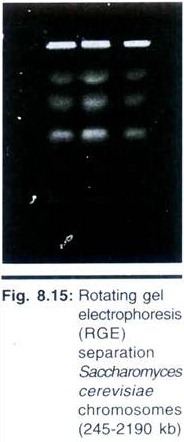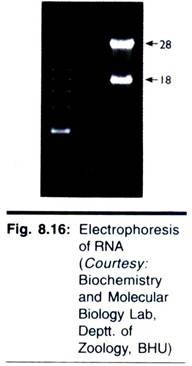ADVERTISEMENTS:
Many clinical tests are being done on the basis of specificity of antibodies for antigen and their ability to recognize epitopes, which is a very small portion or portions of antigen. Antibody based assays are epitope-detecting devices and most of them are based upon the quantitative precipitin curve (Fig. 5.7).
A.1 Precipitation reactions in fluids:
ADVERTISEMENTS:
A quantitative precipitation reaction can be performed when a series of test tubes are taken with a constant amount of antibodies with which the amount of antigens are gradually increased, it starts to generate precipitate.
After the precipitate forms, each tube is centrifuged, pellet is collected by pouring the supernatant and is measured. A precipitin curve is generated by plotting the amount of precipitate against increasing antigen concentration (Fig. 5.7).
The curve shows different zones called:
i. Equivalence zone
ADVERTISEMENTS:
ii. Zone of excess antibody
iii. Zone of excess antigen
Equivalence zone is a zone of forming large multi-mole lattice where the amount of antibody and antigen is optimal. The complex increases in size and precipitates out of solution.
The zone of excess antibody shows the presence of unreacted antibody in the supernatant with some soluble complexes consists of multiple molecules of antibody bound to a single molecule of antigen.
The zone of excess antigen is that region where the unreacted antigen can be detected and small complexes are again observed where one or two molecules of antigen bound to a single molecule of antibody.
A.2 Precipitation in particulate antigens:
Particulate antigens like erythrocytes, bacteria or antigen-coated latex beads are normally evenly dispersed in suspension. The homo-genicity of the suspension is disrupted by the cross- linking of antigen-bearing particles by antibodies, leading towards clumping of the particles, known as agglutination.
The antibodies which produce agglutination reactions are called agglutinins, which is similar in principle with precipitation reaction. The excess amount of antibody inhibits agglutination reactions, called pro-zone effect.
When the antigen is an erythrocyte called hemagglutination or IgM antibodies efficiently cross-link the particles called direct agglutination, or whether an anti-immunoglobulin called indirect or passive agglutination or with bacterial antigen called bacterial agglutination.
ADVERTISEMENTS:
Direct agglutination:
This reaction normally involves IgM antibodies that cross link epitopes on cells or particles. IgM is the largest immunoglobulin has ten epitope- binding sites so they are less efficient in direct agglutination.
Hemagglutination:
It is a regular phenomenon of ABO-blood group antigen when RBCs are mixed on a slide with antisera to the A and B blood-group antigens, may form a clump depending upon this reaction blood transfusion principle is determined (Table 5.4 and Fig. 5.8).
ADVERTISEMENTS:
Bacterial agglutination:
ADVERTISEMENTS:
When bacterial infection, takes place against the surface antigen present on the bacterial wall, generates serum antibodies. This reaction is observed by the bacterial agglutination reaction. The agglutinin titer of an antiserum can be used to diagnose a bacterial infection, when a patient suffers from typhoid fever, shows a significant rise in the agglutination titer to Salmonella typhi. Agglutination reactions also provide a way to type-bacteria.
Passive or Indirect agglutination:
This technique is often used to detect non-IgM antibodies or antibodies in concentrations too low to be detected by direct agglutination. Human antibodies may not directly agglutinate antigen- bearing particles. The sensitivity and simplicity of agglutination reactions can be extended to soluble antigens by the technique called reverse passive hemagglutination test.
In case of this technique RBC is treated with tannic acid or chromium chloride. This helps in detection of antigen in the patient’s serum or in the blood donated by a professional donor. It is used to detect Hepatitis-B antigen in blood to be used for transfusion obtained from a blood bank. It is far more sensitive than precipitation reaction. It is also can be performed with antigen-coated particles of latex (Fig. 5.8).
ADVERTISEMENTS:
Coomb’s test:
This is also called Anti-globulin (Fig. 5.9) test. It may be direct or indirect test.
(i) Direct Coomb’s test:
Sometimes antibodies bind to erythrocytes, do not agglutinate as because the ratio of Ag/Ab shows either excess antigen or excess antibody or electrical charges on the red blood cells, hinder the effective cross linking of the cells.
ADVERTISEMENTS:
These antibodies are called incomplete antibody. To detect the presence of non-agglutinating antibodies on RBC, a secondary Ab can be used. After that they can cross-link with erythrocytes result in agglutination.
(ii) Indirect Coomb’s test:
Sometimes for particular laboratory purpose, it is necessary to know whether a serum sample has particular antibody for specific RBC. By this detection process, the presence or absence of potential non-agglutinating antibodies in the sample can be detected.
In indirect coomb’s method, the RBCs with the serum sample is incubated. After that a wash is taken for removal of unbound antibodies and then a second anti-immunoglobulin component is added and it shows cross-linking with the cells.
Agglutination inhibition:
A modification of the agglutination reaction is called agglutination inhibition which is a very sensitive assessment technique which can even quantify a little amount antigen. In case of home pregnancy test kit, it includes latex particles coated with human chorionic gonadotropin (HCG) and antibody to HCG.
ADVERTISEMENTS:
The addition of urine sample from a pregnant woman, which contains HCG, inhibits agglutination of the latex particles when the anti-HCG antibody is added, thus the absence of agglutination indicates pregnancy. Agglutination inhibition assays are widely used in clinical laboratories to determine if an individual has been exposed to certain types of viruses that cause agglutination of red blood cells.
A.3 Soluble antigens:
The epitopes present on soluble molecules will precipitate upon reaction with the “right” amount of antibody. Precipitates can also form in an agar matrix. The quantitative precipitin reaction requires the preparation.
Single Radial Immuno-diffusion (SRID):
This technique is also called the Mancini technique after the name of the person. It is based upon the diffusion of soluble antigen within an agar-gel which contains a uniform concentration of antibody. Antibody containing molten-agar is poured into a glass slide or plastic dish, gradually cools and solidifies; after that the wells are cut into the gel-matrix.
Soluble antigen is placed into the well (Fig. 5.10 and Fig. 5.11). Antigen diffuses radially from the well, forming a precipitin ring at equivalence. The area of the precipitin ring is pro-portional to the concentration of antigen. The concentration of antigen in a test sample can be accurately determined by comparing its diameter with a standard calibration curve.
The Mancini method is regularly used to quantitate serum levels of IgM, IgG and IgA by incorporating class-specific anti-iso-type antibody into the agar. The limitation of this technique is that it can not detect antigens when the concentration goes below 5-10 μg/ml.
Double Immuno Diffusion (DID):
This technique, also called Ouchterlony technique, is based upon the diffusion of both antigen (located in one well) and antibody (located in another well) through an agar gel forming a concentration gradient. As equivalence is reached a visible line of precipitation is formed. It is an effective qualitative tool for determining the relationship between antigen and the number of different Ag-Ab systems present.
An advantage of this technique is that several antigens or antibodies can be Compared to determine identity (when two antigens share identical epitopes), nonidentity (when two antigens are unrelated epitopes), partial identity (when two antigens share some epitopes but one or the other has a unique epitope or epitopes) etc. (Fig. 5.12 and 5.13).
Immuno-electrophoresis (IEP):
This technique is a modification of double diffusion which is a combination of separation by electrophoresis with identification by double immunodiffusion. Antigens are loaded into a well within the agar, an electrical current is applied and antigens migrate according to their size and electrical charge. The formation of precipitin bands with polyvalent or specific antiserum identifies individual antigen components (Fig. 5.14).
Immunoelectrophoresis is greatly used in clinical laboratories to detect the presence or absence of proteins in the serum and the detection of antibody concentrations qualitatively.
This technique involves three processes called:
i. Rocket electrophoresis
ii. Counter current electrophoresis
iii. Crossed electrophoresis









